Darrah Steffen's Blog, page 9
May 10, 2021
The Chupacabra
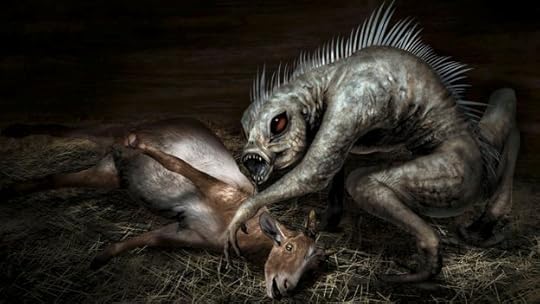
The Chupacabra is a legendary creature in parts of the Americas. Its origins are actually quite recent – with sitings starting in Puerto Rico in 1995.
The creature purportedly has dog or lizard like features and is the size of a small bear. Spines run down the length of its back. The name “Chupacabra” means “goat sucker.” It comes from the creatures attacks and supposed vampirism of goats.
But what is this strange creature? And could its origins be something benign?
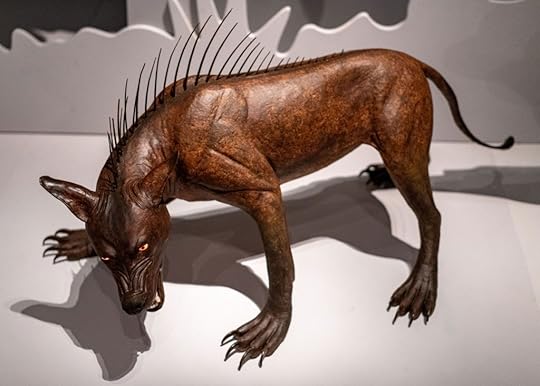 Artist rendition of the Chupacabra
Artist rendition of the ChupacabraAfter the reports of this creature in the mid 90’s, wildlife researchers began looking for an explanation. Eyewitness sitings have been claimed as far north as Maine and even in Sri Lanka. The creatures are most commonly seen in the desert Southwest of the US and Mexico.
 Real life Chupacabra
Real life Chupacabra Researchers found that these poor creatures were dogs and coyotes suffering from mange.
Coyotes in the area became affected with the parasite Sarcoptes scabiei. This parasite caused many of the features claimed to be seen on the new creature: little fur, thickened skin, and a rank odor.
The parasite was able to spread from the coyotes to dogs, further exacerbating the problem.
 Parasite Sarcoptes scabiei
Parasite Sarcoptes scabiei The attack on goats happened as well because of the affliction. These coyotes were weakened due to the parasite. They no longer were able to chase after their faster prey. It was easy to hunt caged livestock.
Even though many reports show that the killed animal was not eaten, this again is common with sick or injured predators. Both dogs and coyotes will not eat their prey due to inexperience or injury.
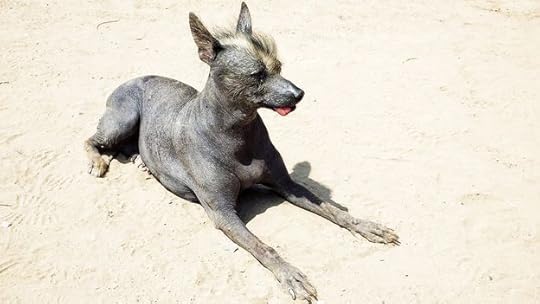 Mexican Hairless Dog
Mexican Hairless DogMexican Hairless Dogs have also been mistaken for the Chupacabra due to its thin hair.
All in all it has been determined that the Chupacabra is an urban legend. The creature came from animals infected by a parasite.
Sources:
https://arquivo.pt/wayback/20090713065825/http://news.mongabay.com/2007/0904-chupacabra.html
Chupacabra mystery solved from Seeker.com
May 1, 2021
Cover of the Month Contest
“Rise of the Dragon Queen” is up for the May Cover of the Month contest through AllAuthors. This is a three tier voting system. And I need your help. Please follow the link below and vote for my book as your favorite cover!
Vote Here!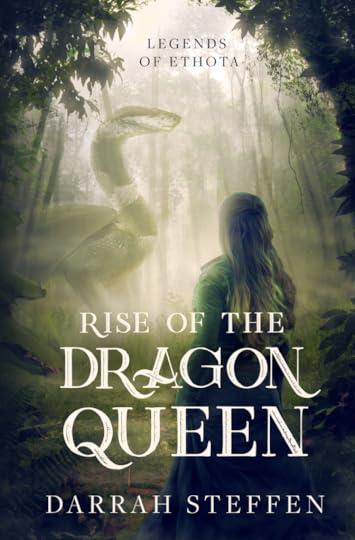
Be sure to also check out the covers of these amazing Indie Authors while you are there:
Feathers of Snow by Alice IvinyaWings of Fate by Skye HornI Belong to the Hunter by Sloane McClainBecoming by Kim CampbellApril 26, 2021
Thunderbird
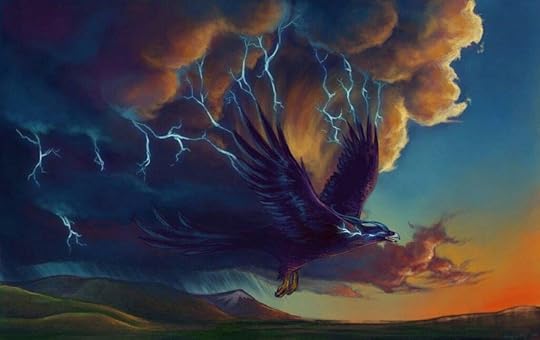
Thunderbirds came to us from North American Indigenous Mythology as a powerful spirit in the form of a bird. By its work, the earth was watered and vegetation grown. Thunder came from the beating of its wings. But where did the idea of the Thunderbird come from?
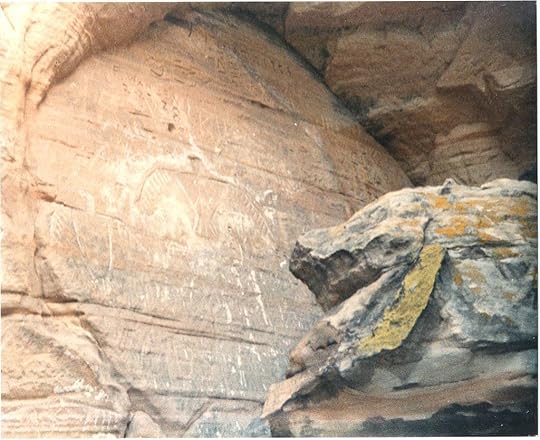 Thunderbird carved into sandstone wall in Wisconsin
Thunderbird carved into sandstone wall in WisconsinThe thunderbird myth is prevalent among the Algonquian peoples in Northeastern Canada and United States – including the areas around the Great Lakes. The idea of this spirit has appeared in many American Indigenous tribes. However, similar figures have been found throughout Africa, Asia, and Europe.
The idea of a Thunderbird may have been inspired by the giant eagles that lived during the Ice Age (Pleistocene). The largest to live is known as the the Haast’s Eagle.
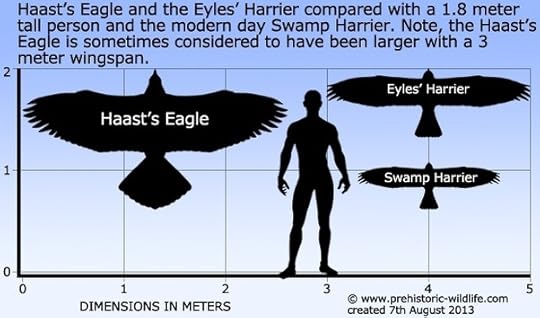 Comparison of the extinct Haast’s Eagle and Eyles’ Harrier to extant Swamp Harrier and human
Comparison of the extinct Haast’s Eagle and Eyles’ Harrier to extant Swamp Harrier and humanThe Haast’s Eagle is an extinct eagle that lived in New Zealand. It is the largest eagle known to have exist with a wingspan over 3 meters and weighting up to 35 lbs. It is larger than our largest vultures today.
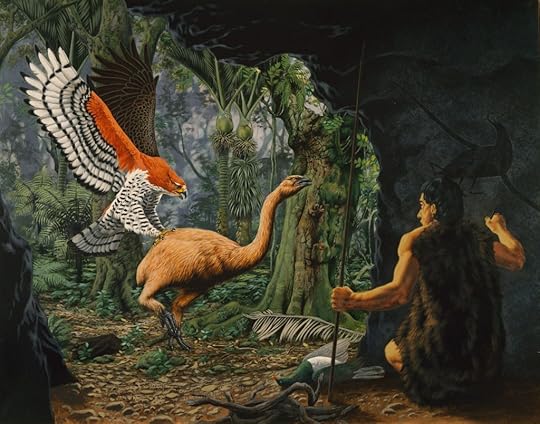 Haast’s Eagle hunting the extinct bird, Moa
Haast’s Eagle hunting the extinct bird, MoaThese large birds preyed on birds similar to the emu that weighed up to 15 times the Haast’s Eagle. Its large beak could be used to rip the into the organs of its prey.
Large eagles like the Haast’s Eagle can explain where the idea of a Thunderbird came from. However, it is regionally locked to Oceania. Many of the Thunderbird myths come from the Americas.
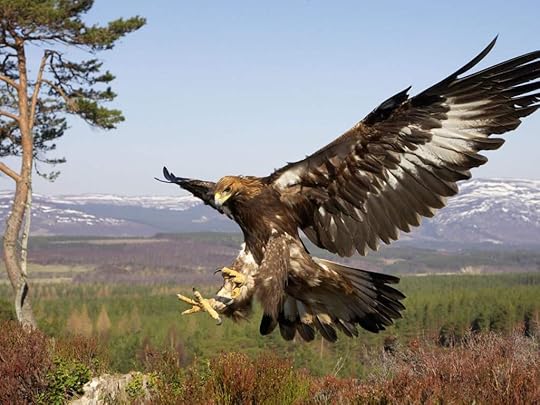 Golden Eagle in flight
Golden Eagle in flightIt is possible that the Golden Eagle may inspired the Thunderbird myth. Golden Eagles are the best-known birds of prey in the Northern Hemisphere. With a wingspan extending up to 2.5 m, they use their speed, agility, and massive talons to snatch up a variety of prey.
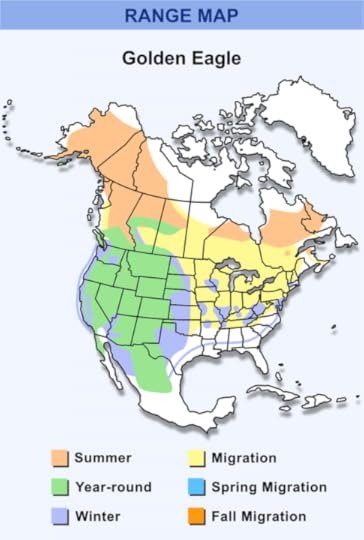 Migration patterns of the Golden Eagle
Migration patterns of the Golden EagleGolden Eagles can be found throughout the Americas. However, they are a migrating bird coming and going with the seasons. Their migrating patterns would take them past the Great Lake Regions as the seasons change and rains are prevalent. This could link the idea of these giant birds with weather, inspiring the myth of Thunderbirds.
Sources:
Brown, Leslie; Amadon, Dean (1986). Eagles, Hawks and Falcons of the World. Wellfleet. ISBN 978-1555214722.
Watson, Jeff (2010). The Golden Eagle. A&C Black. ISBN 978-1-4081-1420-9.
Perry, George L.W.; Wheeler, Andrew B.; Wood, Jamie R.; Wilmshurst, Janet M. (1 December 2014). “A high-precision chronology for the rapid extinction of New Zealand moa (Aves, Dinornithiformes)”. Quaternary Science Reviews. 105: 126–135.
https://www.britannica.com/topic/thunderbird-mythological-bird
April 19, 2021
The Leviathan
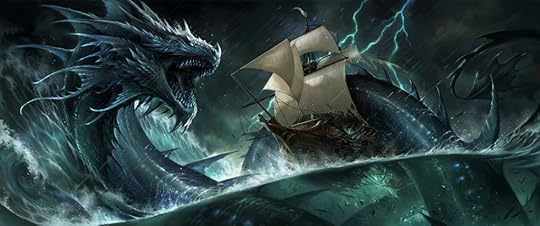
The Leviathan is creature described as a sea serpent in Judaism. It is referenced in several books of the Bible. It is originally cited as a “giant sea monster” in the first chapter of Genesis. It has now become synonymous with any large monster. But where did this creature come from?
According to legend, the Leviathan was a fire-breathing creature of such immense size that the seal boiled when it swam to the surface. It was covered in a thick armor. Swords and harpoon were unable to penetrate its thick skin.
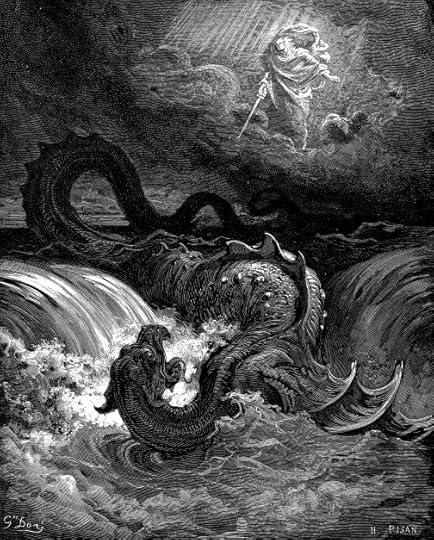 Lithograph of God fighting the Leviathan
Lithograph of God fighting the LeviathanIn Jewish mythology, leviathan comes from the Hebrew Livyatan meaning ‘that which gathers itself into fold’ or ‘that which is drawn out.’ It comes from the Mesopotamian myth of sea monsters of Baal.
Their origins can be traced even further back. Many historians believe that these monsters may be traced to the real world animal the crocodile.
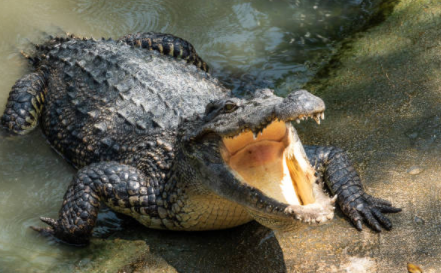 Nile Crocodile
Nile CrocodileThe crocodile is likely candidate for the inspiration of the Leviathan. While the Leviathan is a much larger than the average crocodile, these animals have armored skin making it difficult for the ancient man to kill it. Crocodiles are also able to live in full salinity making it possible for them to survive in the ocean. This would lend credence to the Leviathan’s myth of lurking in the depths and acting as the ruler of the sea.
Other researchers shun this idea, because while it was difficult to kill, it was not impossible. Records show that crocodiles who were hunted by men had their mouths forced open and stabbed the fleshy inside. Notably the Leviathan could never be conquered by man. It took the Judeo-Christian God to kill the female Leviathan and castrate the male. This leads them to believe that the Leviathan’s inspiration came from other, possibly extinct, creatures.
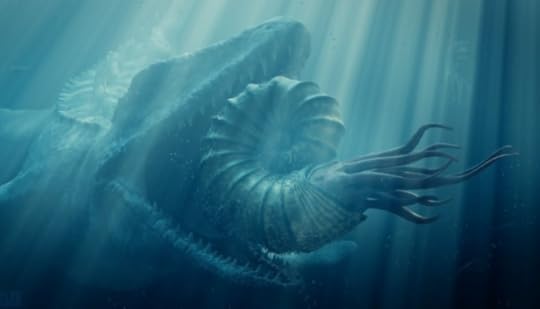 Mosasaur vs Ammonite by Paul Siedler
Mosasaur vs Ammonite by Paul SiedlerMosasaurs are a type of extinct marine reptiles. They lived at the same time as dinosaurs. These animals can be found all across the world – including North America, South America, Europe, Africa, Western Asia, and Antarctica. This would have left their remains in many of the places where the origins of the Leviathan began – notably Mesopotamia.
Mosasaurs were a common large predator in the oceans and the top of their food chain. They had large recurved teeth, which they used to eat virtually any animal. Gut contents have shown they preyed on bony fish, sharks, cephalopods, birds, turtles, and other mosasaurs. They had a second set of teeth on the roof of their mouth allowing them to hold onto their prey.
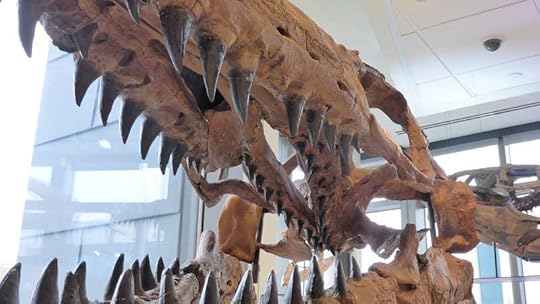 Mosasaur pterygoid teeth. Specimen from Mace Brown Museum in Charleston, SC.
Mosasaur pterygoid teeth. Specimen from Mace Brown Museum in Charleston, SC.Mosasaurs belong to the order Squamata. This is the largest order of reptiles that also includes snakes. Mosasaurs are most closely related to monitor lizards and snakes today. They had long sinuous bodies and swam propelled by undulations of their body.
Much like a snake, Mosasaurs had double hinged jaws that would have unhinged when they bit down on large prey items so they could hold it better or sink their teeth in further. The double-hinged jaw can be found in the same relative location it is found in snakes. This would further have allowed Mosasaurs to rule the ocean
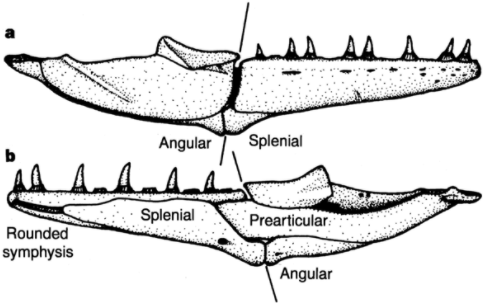 Figure showing similarities between the structure of a snake and mosasaur jaw. a: Snake jaw b: Mosasaur jaw
Figure showing similarities between the structure of a snake and mosasaur jaw. a: Snake jaw b: Mosasaur jaw It seems likely that the mosasaur inspired the myth of the Leviathan. Since the creature was already extinct, the bones would have become permineralized. This would have them turned them hard like stone. It would have made it difficult for early man finding this “monster” in a cliff to kill the beast. The animal would continue lurking until it either rolled out of the cliff or washed away.
Sources:
https://www.mythicalrealm.com/creatures/leviathan.html
https://www.geol.umd.edu/~jmerck/geol431/lectures/d09serpentes.html
A.S. Schulp; H.B. Vonhof; J.H.J.L. van der Lubbe; R. Janssen; R.R. van Baal (2013). “On diving and diet: resource partitioning in type-Maastrichtian mosasaurs”. Netherlands Journal of Geosciences. 92 (2–3): 165–170. doi:10.1017/S001677460000010X. S2CID 131884448.
Wilhelm Gesenius, Samuel Prideaux Tregelles (trans.) (1879). Hebrew and Chaldee lexicon to the Old Testament.
Leviathan
April 15, 2021
Vote for your Favorites!
Rise of the Dragon Queen is up for an award with 2021 Reader’s Choice Awards through TCK Publishing! If you like what you have seen on my blog and website OR if you like my book, be sure to vote for Rise of the Dragon Queen as your favorite Young Adult Book!
 Vote here!
Vote here!Rules:
You may have to disable pop-up blockers to vote depending on your web browser. The pop-up notification when you vote is necessary so that bots and spammers cannot vote.If you are clicking on a book to vote but nothing is happening, scroll down the page and click “Change Vote” (it’s right above the “Share on Facebook” button)You can vote one time for ONLY ONE BOOK per category.Just click the arrows on the left and right side of the voting form to navigate between categories.Click on the BOOK TITLE of your favorite book to cast your vote and then you’re set to view your results.To change vote, just click on the “CHANGE VOTE” option on the lower left corner of the voting form (just above the Facebook sharing option) and then click on the title of the book you want to change your vote intoOnly one vote per IP address will be accepted. Offices and schools usually only have one IP address, so it would be best to vote from home to avoid losing votes.The awards committee will check the legitimacy of each vote before announcing the winners.** You will find Rise of the Dragon Queen on page 12 in the Young Adult category**
April 14, 2021
Vote for Rise of the Dragon Queen!
Rise of the Dragon Queen is up for an award with Author Elite! If you like what you have seen on my blog and website OR if you like my book, be sure to vote for Rise of the Dragon Queen as best Young Adult Book!
 Vote here!
Vote here!Rules:
Click on the linkNavigate through each category.Click 1 book to vote for*Note: votes are unable to be changed after they are clicked!
** You will find Rise of the Dragon Queen on page 12 in the Young Adult category
April 12, 2021
Bigfoot
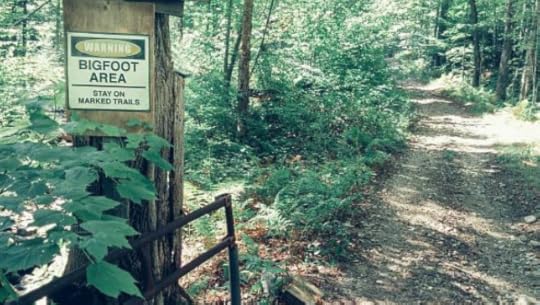
The idea of Bigfoot has become popular in Canadian and American folklore. It is a hairy, humanoid creature that lives in the forests of North America. Many people go “Bigfoot Hunting” and have reported sightings. But where did this myth come from?
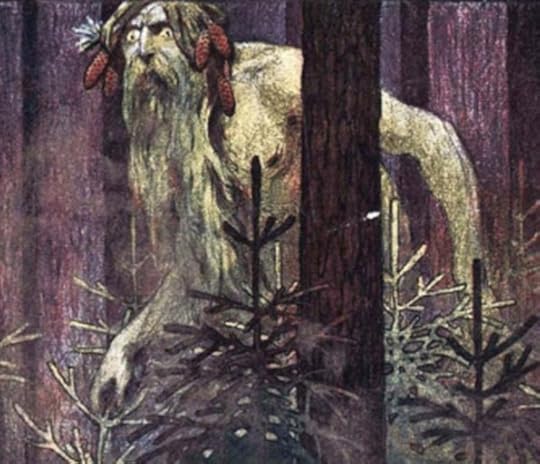 Depiction of the Wildman
Depiction of the WildmanFolklorists trace the figure to a combination of sources, starting with the European “Wild man.” This creature was derived from the Roman god of the woodlands and was akin to a faun. His popularity in the 12th century showed him covered in hair and encountering the Green Man.
Other instances of this “Bigfoot” creature have cropped up in other regions of the world including the Mongolian Alma, Himalayan Yeti, Chinese Yeren, and Australian Yowie. These creatures can all tie their origins back to traditional folklore.
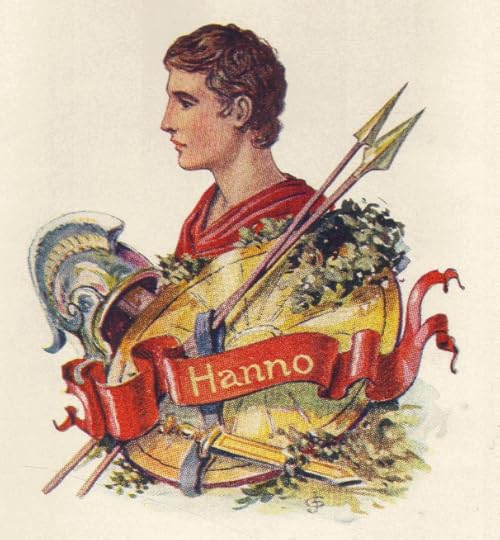 Depiction of Hanno the Navigator
Depiction of Hanno the NavigatorIt has been postulated that these stories have cropped up from an ancient explorer called Hanno the Navigator. Hanno explored the African coasts in the 5th Century B.C. It is thought he possibly pushed as far south as Gabon.
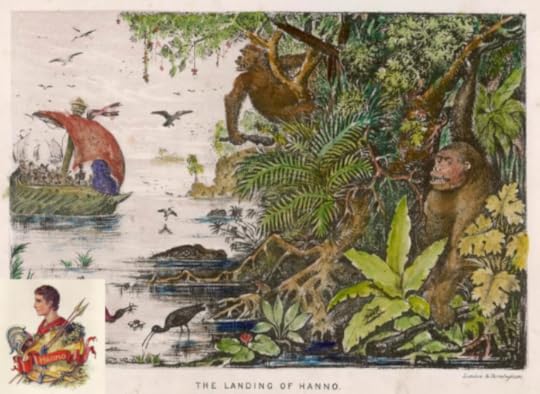 Traditional print of the Landing of Hanno
Traditional print of the Landing of HannoAt the terminus of Hanno’s voyage, the explorer found an island heavily populated by a hairy and savage population. Three women were captured, killed, and their skins taken home. The interpreters travelling with Hanno called the people Gorillai.
It was not until the 19th century that these Gorillai of myth were determined to a species of ape.
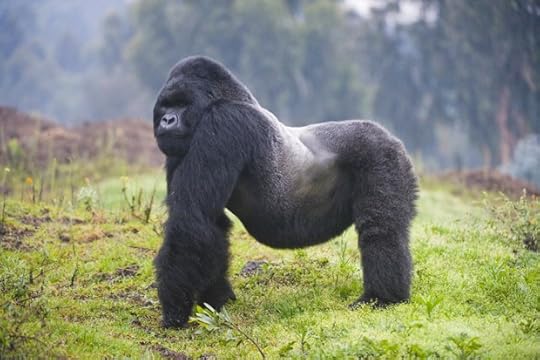
What Hanno the Navigator had inadvertently described and what many of these myths can be traced back to is the Mountain Gorillas of Africa.
Today just over 1,000 gorillas exist in the wild. They live in two isolated groups in east-central Africa. The gorillas prefer high altitude montane and bamboo forests.
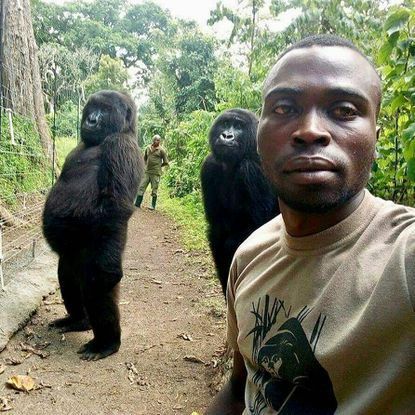 Gorillas posing like humans for a selfie with their Ugandan handler.
Gorillas posing like humans for a selfie with their Ugandan handler.It is not surprising that upon first discovery, gorillas were mistaken for a hairy version of humans. We share 98% of our DNA with gorillas. We have many shared characteristics from the structure of our bones to our large brains. This shared DNA also means that every illness we can catch, they also can. However, gorillas haven’t developed the necessary immunities.
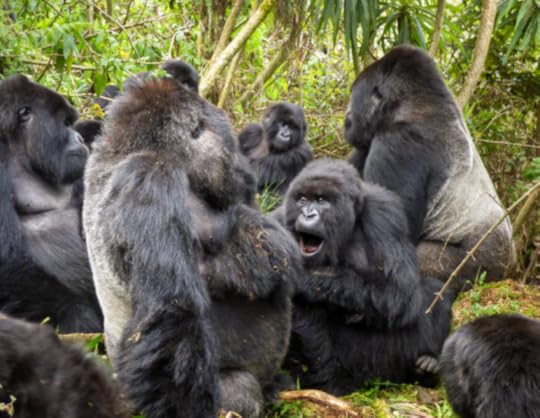 Family Groups
Family GroupsMuch like humans, gorillas are very social creatures. They live in stable family groups of around 10 individuals with one dominant male and several females. This further indicates that Hanno did indeed come into contact with a group of gorillas. He stated, “… The biggest number of them were females, with hairy bodies…Chasing them, we could not catch any of the males.”
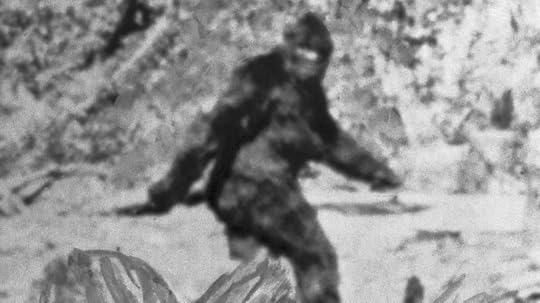 Blurry photo of Bigfoot from 1970’s
Blurry photo of Bigfoot from 1970’sThe idea of Bigfoot has changed and evolved as the years have passed and the story has been passed through the lenses of different cultures. It can be postulated that the idea of Bigfoot most likely came from early sightings and stories brought back of Mountain Gorillas.
If you would like to support the conservation efforts to save these beautiful creatures, check out the World Wildlife Fund.
References:
https://www.wwf.org.uk/learn/fascinating-facts/gorillas
Walls, Robert E. 1996. “Bigfoot” in Brunvand, Jan Harold (editor). American Folklore: An Encyclopedia, p. 158-159. Garland Publishing, Inc.
“Beyond Bigfoot”. amnh.org. American Museum of Natural History. Retrieved March 18, 2021.
Law, R. C. C. (1978). “North Africa in the period of Phoenician and Greek colonization, c. 800 to 325 BC”. In Fage, John Donnelly; Oliver, Roland Anthony (eds.). The Cambridge History of Africa. 2. Cambridge University Press. pp. 87–147. ISBN 978-0-521-21592-3.
April 10, 2021
Interview with Scrolls and Screens Podcast
Check out my interview on the Scrolls and Screens Podcast with host Melissa Matos. It is an Indie-scovery podcast shining a light on indie authors.
If you want to learn more, check out their websiteScrolls and ScreensApril 5, 2021
Interview with Helen Garraway

I recently had an interview with fantasy author Helen Garraway. She asked me questions about my recent release Rise of the Dragon Queen.
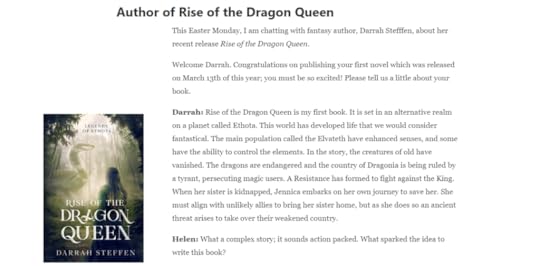
To see the full interview, check out Helen’s website!
Read full InterviewInstagram Giveaway!

Do you like free books?
I have teamed up with 10 other Indie Authors to put together this giveaway for you! You could win one of the amazing prize packs! Check out the rules below!
 GIVEAWAY
GIVEAWAY 
We have an amazing fantasy giveaway for you all. The giveaway will run from today (April 4th) until April 11th. There are seventeen fantasy books altogether up for grabs, divided into seven prizes. Swipe right to see them. Rules: To enter you must be following the authors (on Instagram):
@rebeccalgarciabooks
@k.l.kolarich
@jodigallegos_
@ajsteffort
@rebeccagreyauthor
@aimeeshayeauthor
@sarahmcradit
@sherry_ficklin
@llhunter
@darrahsteffenwrites
@caitlindenmanbooks
Comment when you’ve followed all the authors, and like this post.~
Prize 1: The Fate of Crowns and The Princess of Nothing by Rebecca L. Garcia

Prize 2: House of Bastiion by K. L. Kolarich and The High Crown Chronicles by Jodi L. Gallegos

Prize 3: Shattered Kingdom by Angelina J. Steffort and Vengeance by Rebecca Grey

Prize 4: The Broken Daughter by Aimee Shaye and The Kingless Crown by Sarah M. Cradit

Prize 5: A Stolen Empire Boxset by Sherry D. Ficklin

Prize 6: Daughter of Darkness by L. L. hunter and Rise of the Dragon Queen by Darrah Steffen

Prize 7: She Awakens. Brand New Release by Caitlin Denman

Hosts are exempt from follow backs. Winners will be announced in my stories. US entrants only.
Q: How many of these books have you heard of or are most excited to read? (Question is optional and not a part of the giveaway)#bookgiveaway#bookgiveaways#bookstagram#booksbooksbooks#booksofinstagram#bookish#bookishlife#bookishpost#booklover#fantasybooks



